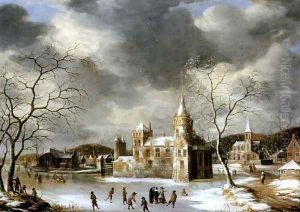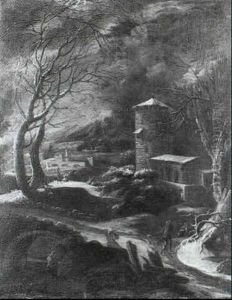Abraham Beerstraten Paintings
Abraham Beerstraten was a Dutch painter who specialized in winter landscapes and town views, active during the Golden Age of Dutch painting in the 17th century. He was born in Amsterdam in 1622 into a family of artists; his father, Jan Abrahamsz Beerstraten, was also a painter, as was his brother, Jan Beerstraten. The Beerstraten family is often associated with finely detailed paintings that capture the essence of Dutch urban and rural life during this period.
Abraham's works are characterized by their meticulous attention to the play of light and shadow, and the use of perspective to create depth in his snowy townscapes. His paintings often feature frozen canals, snow-covered buildings, and figures going about their daily activities, highlighting the interaction between the Dutch people and their winter environment. Despite the cold scenes depicted, Beerstraten's paintings exude a warm, lively atmosphere, inviting viewers into the charming settings.
Beerstraten's contribution to Dutch art is particularly noted for his ability to convey the textures of different surfaces, from the crunchy snow to the slick ice, and the roughness of tree bark, all within the same composition. His works also sometimes included summer landscapes and seascapes, but it is his winter scenes that stand out for their unique charm and technical prowess.
Details about Beerstraten's life, training, and career are relatively scarce, but it is known that he worked in Amsterdam for the entirety of his career. Like many artists of his time, he was likely to have been a member of the local Guild of Saint Luke, the city’s painters' guild. Abraham Beerstraten passed away in 1666, leaving behind a legacy that captures the serene and picturesque quality of Dutch winters in the 17th century. His paintings continue to be admired for their historical value and their contribution to the iconography of the Dutch landscape genre.












